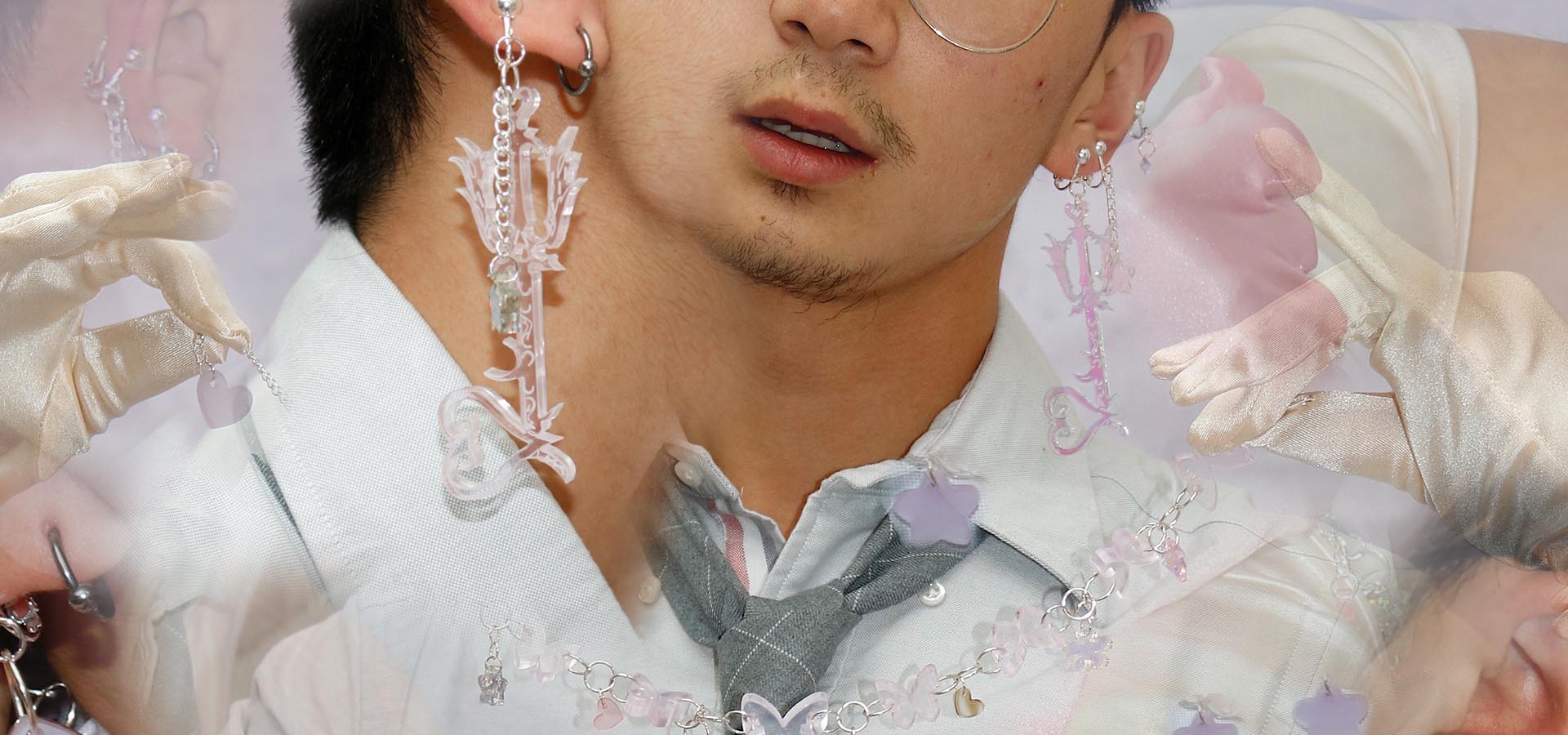
The Passion of the Saeculum:
An Interview with Emma Pryde
November, 2019
Emma Pryde is a multidisciplinary artist who crafts an image world unmistakably her own. Pryde’s videos, wearables (!), ceramic objects, and installations evoke enigmatic messages as disparate as the undercurrent of terror latent in late 90s and early 00s child ephemera, or the ecosocial effects of attachments to transhistorical performances of fantasy. This interview largely centers itself around the discussion of her exhibition Saecularis, done with Pretty Days, a project run by artists Harry Gould Harvey IV and Gregory Kalliche, which uses portable tents as the spatial anchor for their shows.
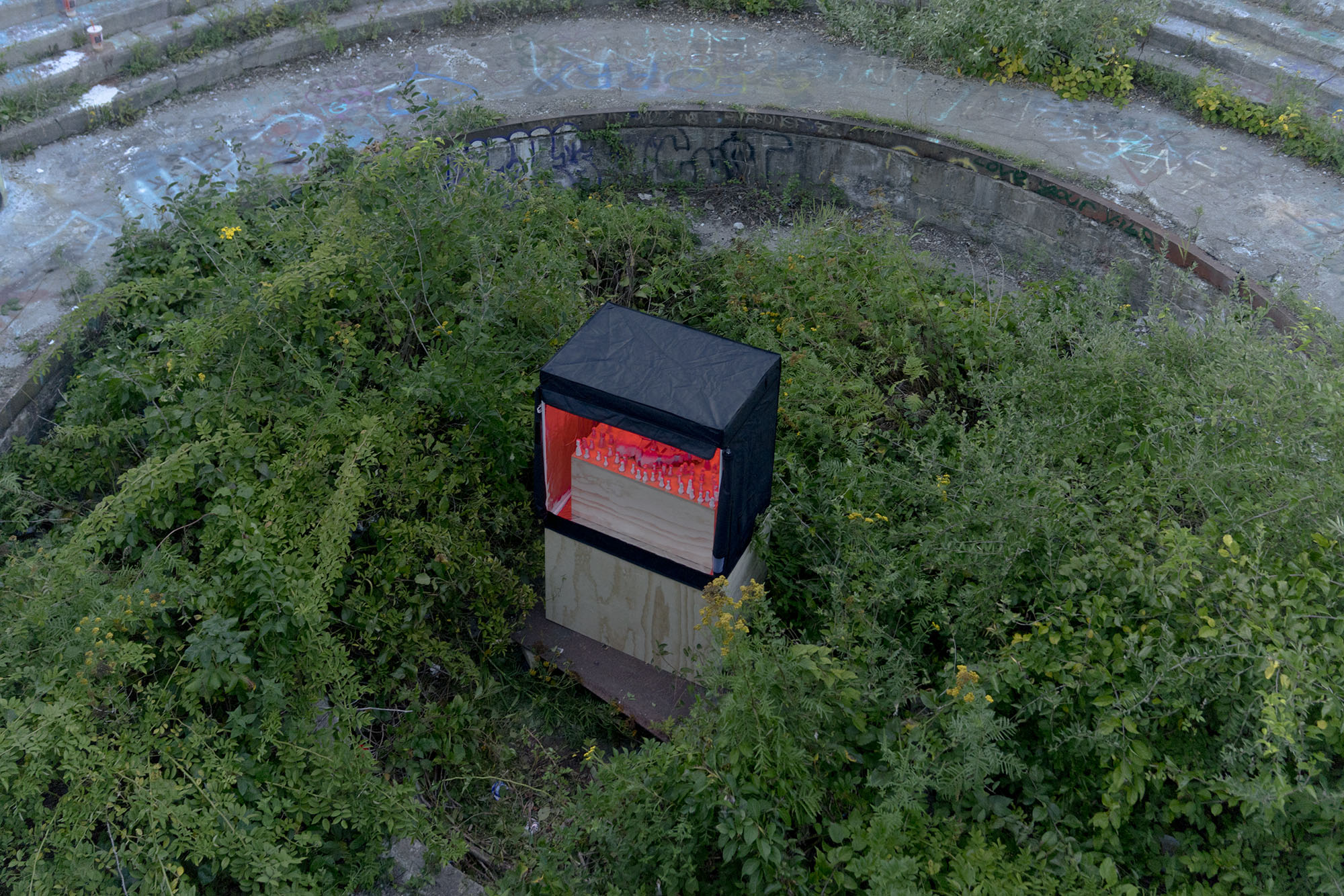
GJ: We can utilize your Pretty Days show as an entry point… I was wondering if you could talk about the figures at play in Saecularis.
EP: I’ve been making hundreds of little wax figures— they’re tiny “boy” and “girl” angels. For every twenty or so angels there’s a priest figure with a mask that leads them around. The angels are like serfs and the priests are like lords, and in Saecularis there’s this big ceramic mummy that they’re all crowded around in mourning. I’m interested in building these loose narratives with different characters, and creating hierarchy through scale and quantity. The characters represent various roles in a hegemonic structure.
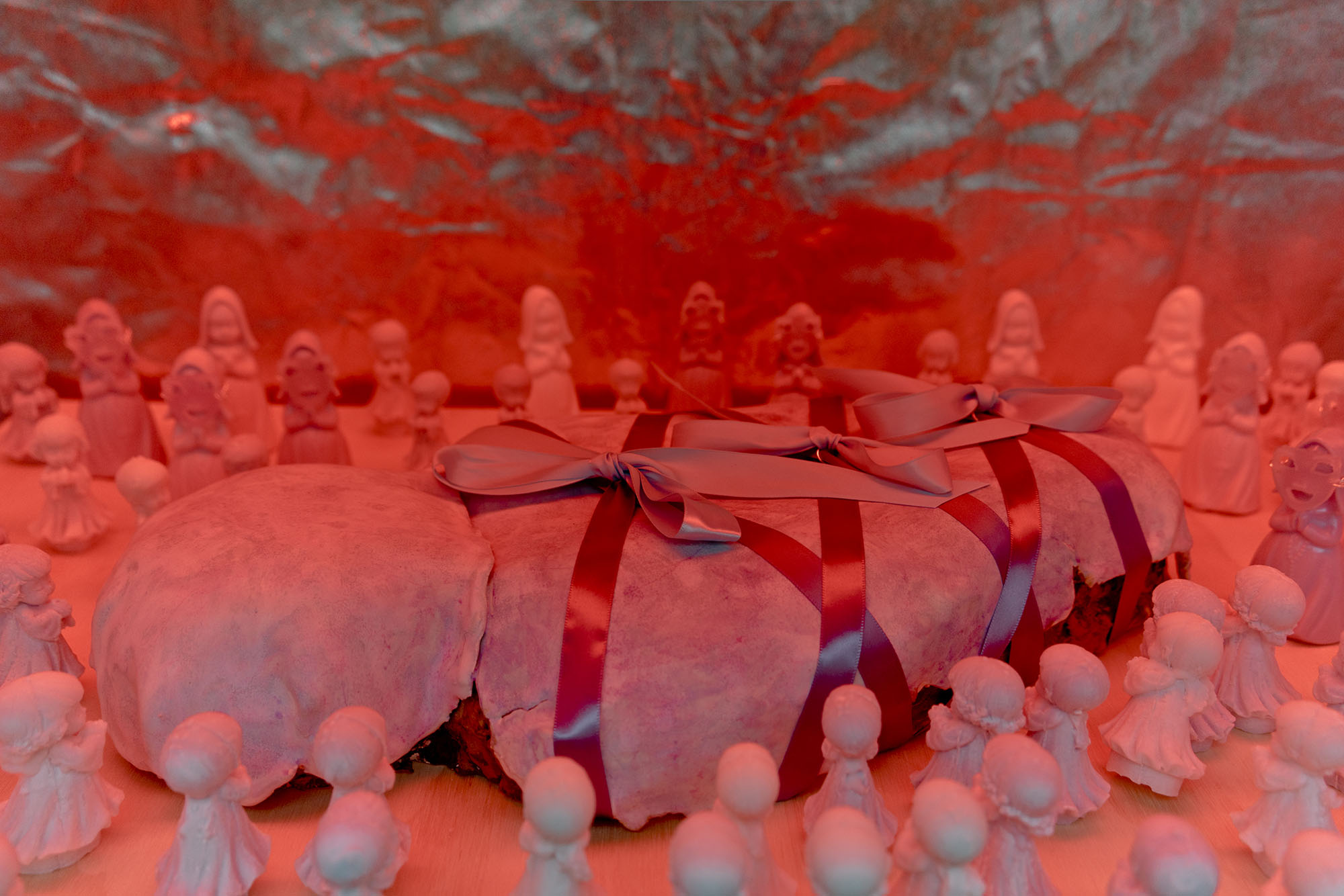
GJ: I see these pieces as being really modular or capable of infinite reconfiguration, and I was wondering how a work like this would appear as a changed installation elsewhere or as part of a larger series, in a way that would imply the passage of narrative time, or even “external time” due to their materiality, since they’re made of wax and could be morphed by environmental conditions.
EP: I like wax for that reason. I’ve broken so many of the figures— their heads will come off and I can just re-melt their heads onto their bodies. I wanted to work in a way that was scalable— you could have a small number or an entire army and they can occupy different spaces with differing formations.
GJ: What do you make of angels often being configured as children in popular religious imagery? To me, this always implies that they’re… dead children, beings who have passed on, or maybe never even survived the womb, or something like that? Were there specific religious or mythological constraints you used in conceptualizing the angels, or are they not adhering to a life/death binary?
EP: The angels come from a larger project I am working on where they represent prisoners. In the Saecularis context maybe they are in another alternate realm of the underworld, attending a funeral. When I was thinking of titles for the show I was looking at these different graveyards in L.A. The Forest Lawn graveyard in Glendale has a baby graveyard called ‘Lullaby Land’ in the shape of a heart. In Burbank there’s a cemetery called ‘Portal of the Folded Wings,’ which is a shrine for pioneers of aviation. All of my angels’ wings broke off, they’re damaged and they can’t fly. I didn’t think of it before but now that you mention it the Pretty Days’ infrared healing tent does look a lot like a womb.

GJ: I was thinking about this in the context of the research influences you sent me before this interview— specifically The Millennials painting by Lynn Randolph, or Donna Haraway’s description of it rather, how she says, “Sober in their regard, the children are not destroyed but menaced by an apocalypse that burns and engulfs the world.” She also discusses a “comprehensive futurelessness” and “blasted futures.” It’s interesting that we’re talking today, on the day of the child-led global climate strike. In lieu of these contexts, I have been thinking a lot about some idea of memorials for future children, and that idea of potential as simultaneously motivating climate action now as a thing that will either be lost or rescued— the rhetoric of “your children” or “your children’s children,” future children being the only way we can urgently evoke climate catastrophe rather than thinking about it as a present. It’s my belief that children, generally, are also not conceptualized as beings-in-real-time, but are rendered futures or potentials themselves waiting to be activated. It seems like climate catastrophe or its specter is something on your mind, with the Haraway you sent me and the Randolph painting. How does that figure into the work you’re making?
EP: Children are symbolic of innocence, and in that painting the girls embrace as the world burns around them. I can relate to that image— the world around us may seem like a Boschian nightmare, but as witnesses we have hope in each other. The world we came into is structurally broken in a lot of ways and we need to recognize those underlying systems in order to dismantle them.
GJ: The drama of those structures plays out in your work in a complex manner: a hierarchy is menacingly implied in Saecularis, but there’s also the feminine palette and the smallness of the figures, which creates a tension between the form and narrative. How is using an image world usually thought of in terms of play or girlishness helpful in considering some of the destruction wrought by capital, or however you want to phrase it?
EP: I think it’s about confronting powerlessness and inviting people to reconsider visual languages that are often seen as naive or pathetic. My process is very intuitive, I work with images and symbols that present themselves to me as metaphors, and I construct works or installations that have their own internal rationale. I think of play as a form of fantasy, both are subversions of reality. When a child constructs a doll house with different parts, the process is also about agency, in creating parameters and rules for one’s own world. Role-playing is more than just dressing up as characters; we also inhabit roles and identities in society that are a product of social conditioning. My palette and imagery is informed by media that is meant to define or control women especially from a young age. I’m interested in interfacing with this media because I myself find it seductive and enchanting, and that both disturbs and excites me.
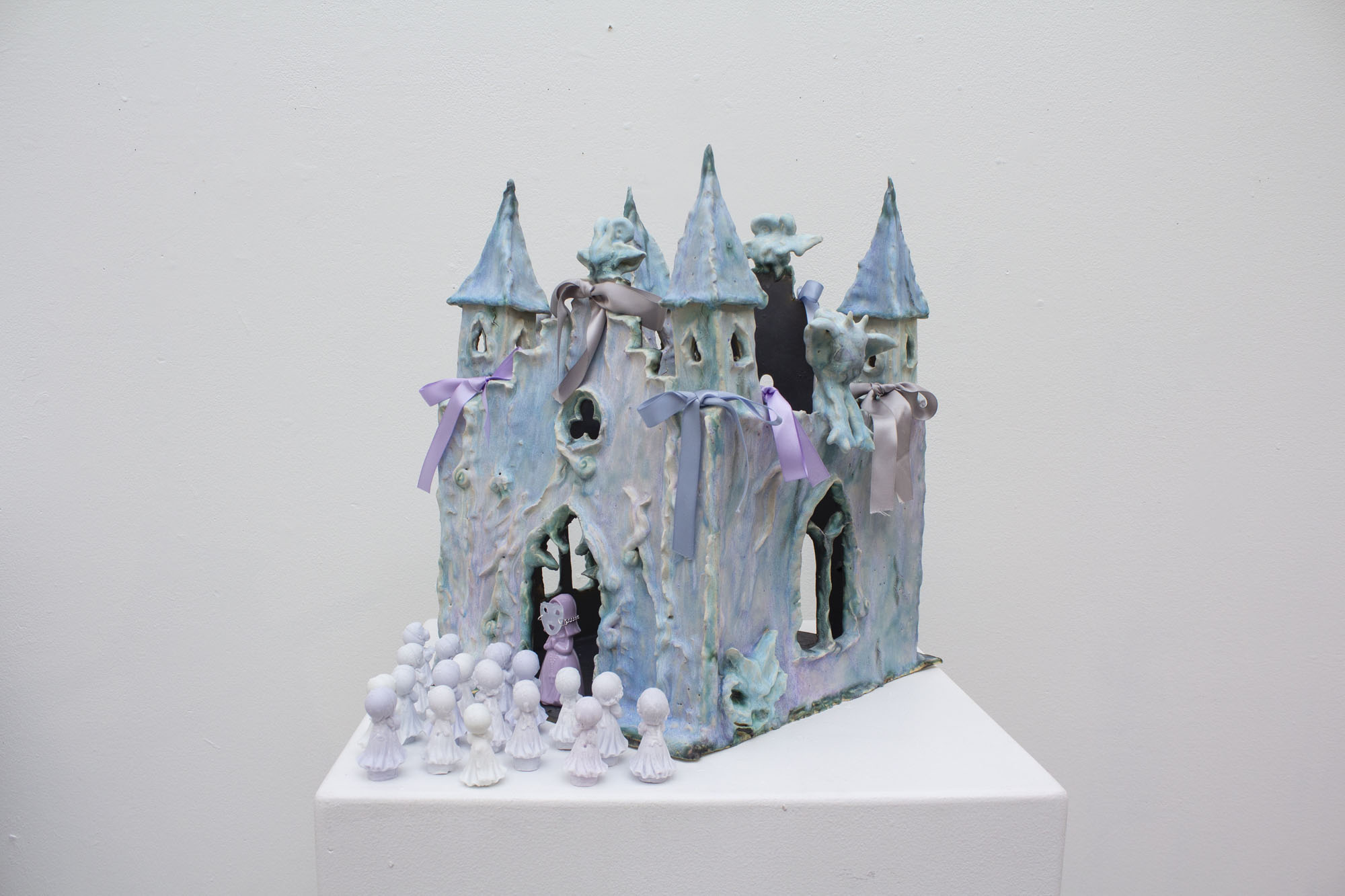
GJ: In your work you’ve employed many different tropes of storytelling and symbolisms used as structures for understanding the world, as modes of identity construction. There are the more Egyptian references with the Sphinxes, the Greco-Roman influences with the clay masks or mythological characters, and then Saecularis almosts feels reminiscent of mannerist work in an oblique way. The laser-cut masks that have a more contemporary theatrical feeling, but then also there are angels that look like a 90s icon— the Precious Moments figurines. How do you think that you’ve arrived at this particular set of symbols from what you were doing earlier?
EP: I’m interested in the language of art history— the idea of the artifact or the museum… history is a product of a Western fantasy meant to impose hierarchy and ideology, and in the ceramic work, I was trying to play with that idea a bit by creating artificial artifacts from a fictional planet with a religion based on kids television and video game culture. My new body of work is made primarily out of plastic and slip-cast porcelain, and there is less of the ‘artist’s hand’ in it, since the processes are reproducible. Now, I’m working with cliches about postmodernism, which are in conversation with commercial and domestic objects. The imagery and materials that I am using represent a form of unfulfilled desire I felt as a child. Desire for objects, desire for objects to come to life, desire to possess and control an object in the hopes of not becoming an object myself.
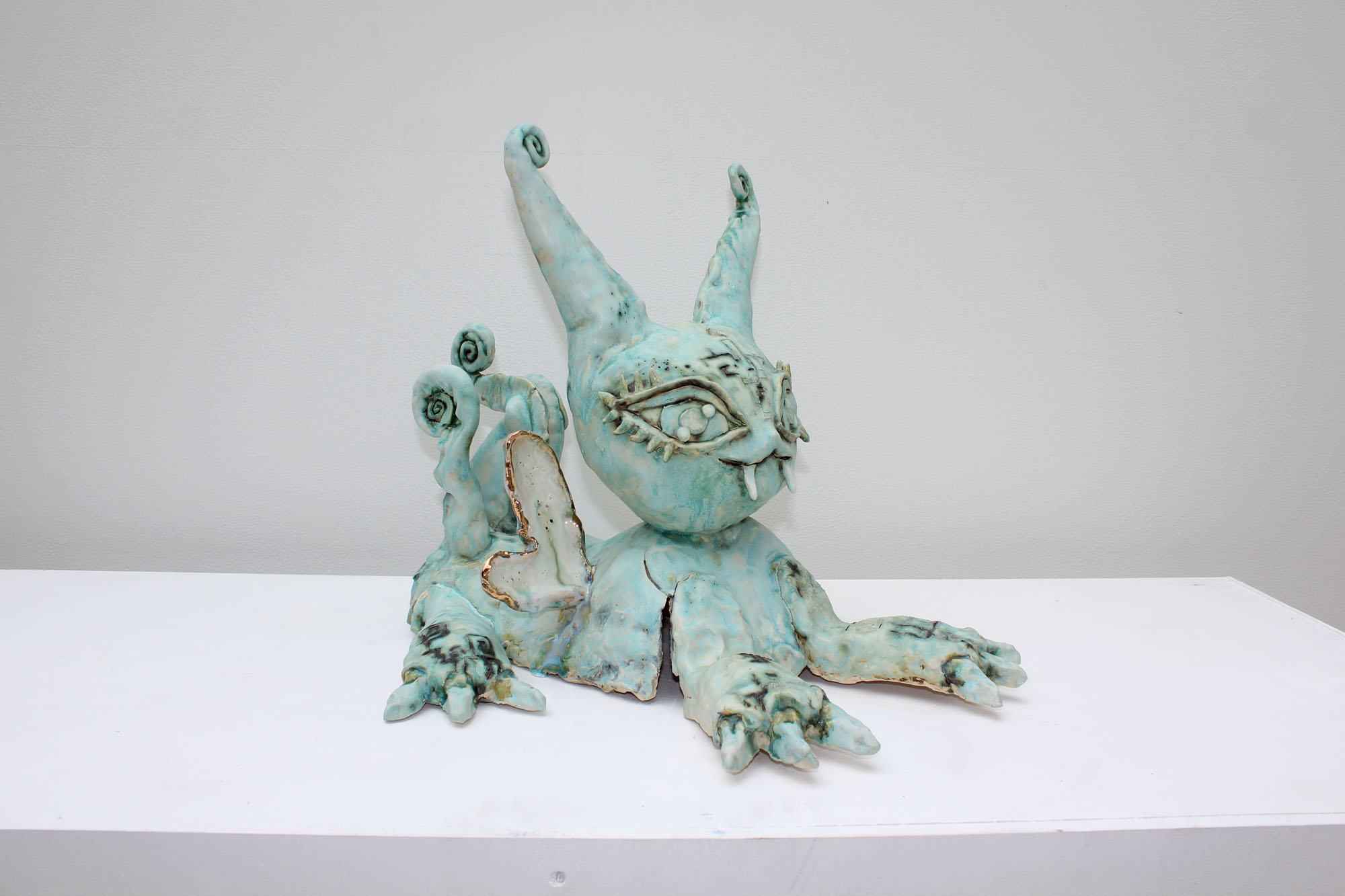
GJ: Are these newer works in any way related to or informed by Precious Moments, or is that imagery a cipher for something else?
EP: The works aren’t directly related to Precious Moments but there’s a definite connection and similar formula: baby + religion. I am inspired by the way Precious Moments infantilizes Christianity. The Precious Moments brand creates fetish objects that inspire new and bizarre ways of worship by combining consumer culture with religion. It’s basically the opposite of what religion is supposed to teach, but as Americans we really embrace those contradictions, the demonic side of the angelic.
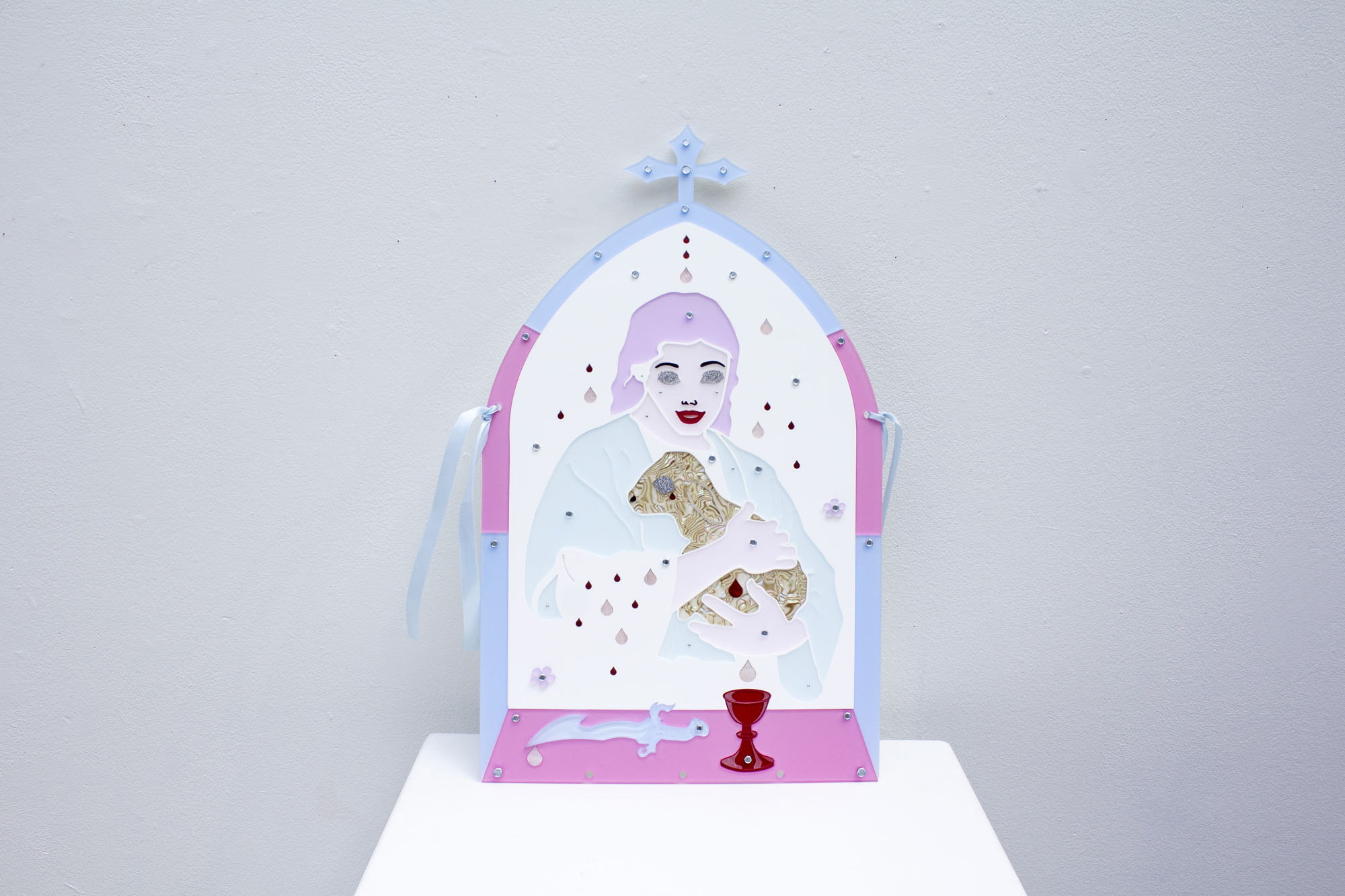
GJ: Yeah, and in thinking about the everyday nature of these objects, I noticed that the acrylic masks in this work mimic the wearables that you’re making. I am wondering how these different elements of your practice work together, or why you started making wearables, and why you think more artists now are choosing to do that— where that impulse comes from, and how the wearables you make are more readily consumed and more accessible.
EP: When I’m making the lasercut pieces there’s a lot of excess acrylic. I don’t want to create any plastic waste, so I use the scraps to make the jewelry. Selling the jewelry helps me afford the material for my artwork, and it feels more sustainable. I have a lot of respect for artists who can support themselves in ways outside of institutions and the gallery system. People should support artist-produced fashion because it is oppositional to fast-fashion that ends up in a landfill. Making smaller, wearable, multiples allows people to buy a piece of my work that they can actually use. I’m really grateful for the support people have shown with my jewelry. It has added a whole new dimension to my art practice and makes me feel that I have more agency as a working artist.



GJ: That’s amazing. So going back to Saecularis… what does the word itself mean to you?
EP: It relates to the saeculum, which is more or less the lifetime of a generation, but saecularis sounds like a disease. I’ve been reading this book called The Fourth Turning, which is about how the world goes through four generational cycles— high, awakening, unraveling, and crisis. The book was written in the 90s during the “unraveling,” and now we are in the crisis part of the cycle. As millenials, our generation is hyper aware of economic collapse, ecological disaster, and political injustice— we are in a space of mourning, rather than awakening.
GJ: It is certainly a time of mourning. The idea of possibility, or the hope instilled in potential, has been foreclosed in this moment. But I feel like now we’re constantly negotiating sheer denial, loss, wanting to indulge in beauty but not pleasure, and there’s so much guilt in dealing with environmental catastrophe. This idea of apocalypse— it being something that our generation didn’t directly engineer but was wrought mostly by the ones before us— is now our responsibility to deal with.
EP: Yeah, I think that’s a really interesting idea of beauty over pleasure. Not manufactured beauty but true beauty, like in music or art or nature. True beauty is a sign of hope that everything isn’t meaningless. Beauty is poignant at this moment because it feels so fleeting and separate from the prevailing infrastructures and mass media around us. We now have to reckon with the death of the natural world, and it’s really painful.

GJ: You could say that we are the last generation of people who grew up in cultures of widespread climate denial, whereas now it’s more extremist to not address climate change rather than face it. It’s interesting to see how with climate rhetoric, how even a few years ago with the big green march, the rhetoric was all about “our children,” or “do it for the future generations,” whereas now it has changed to be: “climate change has arrived.” The children of today are saying, “you have failed us.” There are children suing governments for failing to protect them, which is beautiful, resilient, and so, so sad. I guess, going back to the work, do you have an explanation for why the priests are wearing masks, and what is the mummy that the figures are all mourning, why it is so much larger than them, and why it’s wrapped up like a present? I feel like this is in some way connected to the discussion we’ve been having about futurelessness.
EP: The angels are mourning this decorated larger ideal, a blank representation of their god. The priests are wearing masks because they aren’t revealing their true motive, and they are guiding the children to a negative end. The masks are based on Barbie’s smiling face.
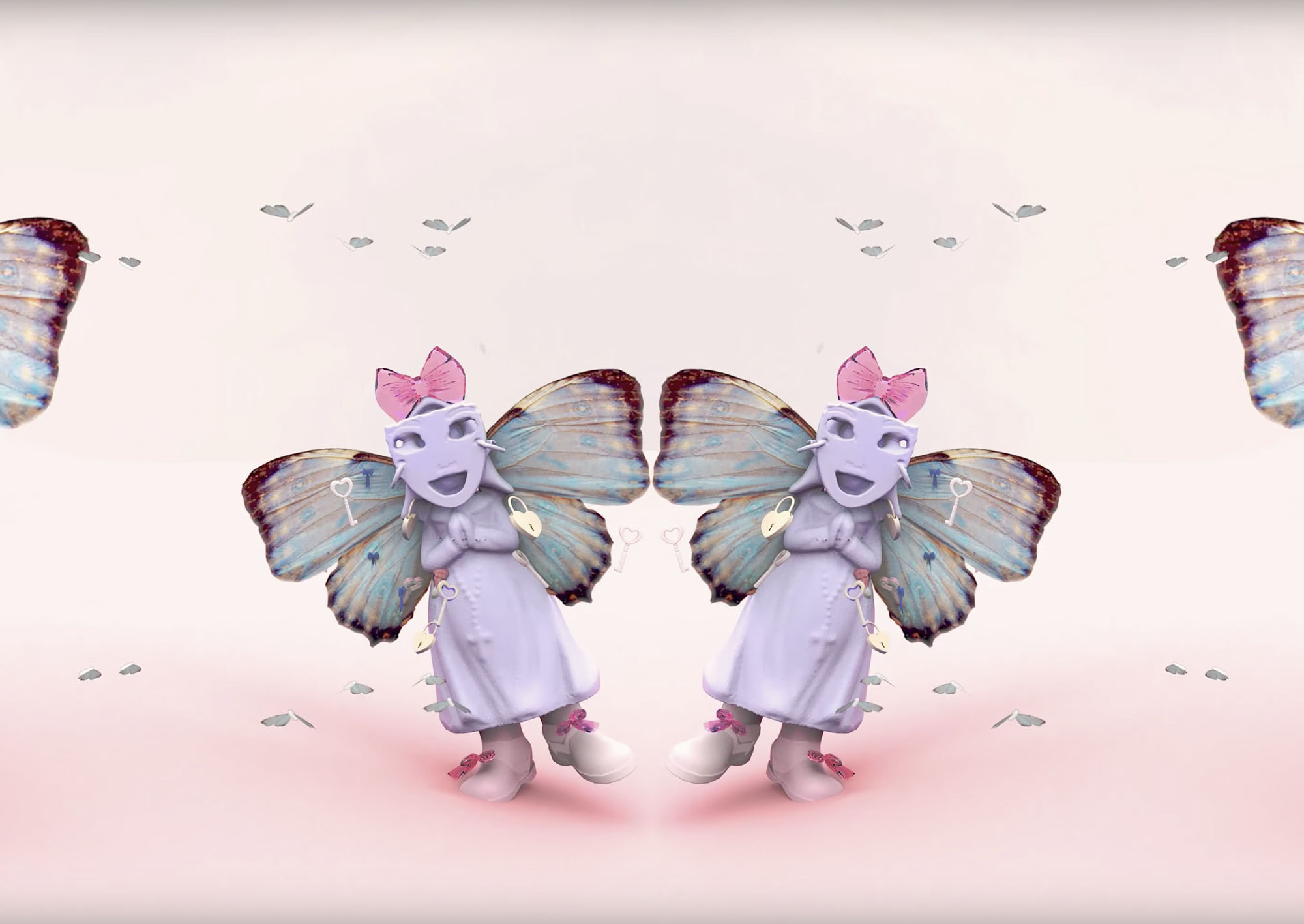
GJ: I thought of them as the classic two-faced politician, or representative of how the church used to be the main political actor and domain.
EP: It’s that as well— using the Barbie mask is a metaphor, it’s all about power that upholds the status quo, but existing in a toy world. It may look really appealing and cute but there’s a secret order underneath that keeps the hierarchy in place.
GJ: Yeah, they look like they’re gathering around some monument or memorial too, or a funeral pyre, something larger than life. A type of thing that’s in the human likeness but has entered into another dimension, but that humans made, so it’s this funny contradiction. I think, historically, sphinxes, the temples, the church were very narcissistic, self-congratulatory enterprises. Like, “okay let’s make this monumental thing in service of a higher power or realm, but don’t forget we humans did it and it’s really cool.” It’s amazing regardless. But now you see a similar narcissism playing out with technological feats; it’s unabashedly pro-human, or humanist, but in a way that’s ultimately more destructive to our current idea of the human.
EP: Yeah, it’s wide-scale destruction with the promise of progress. Technology is an interesting replacement for religion, and the temptations of these “higher realms” are used as mechanisms of control.
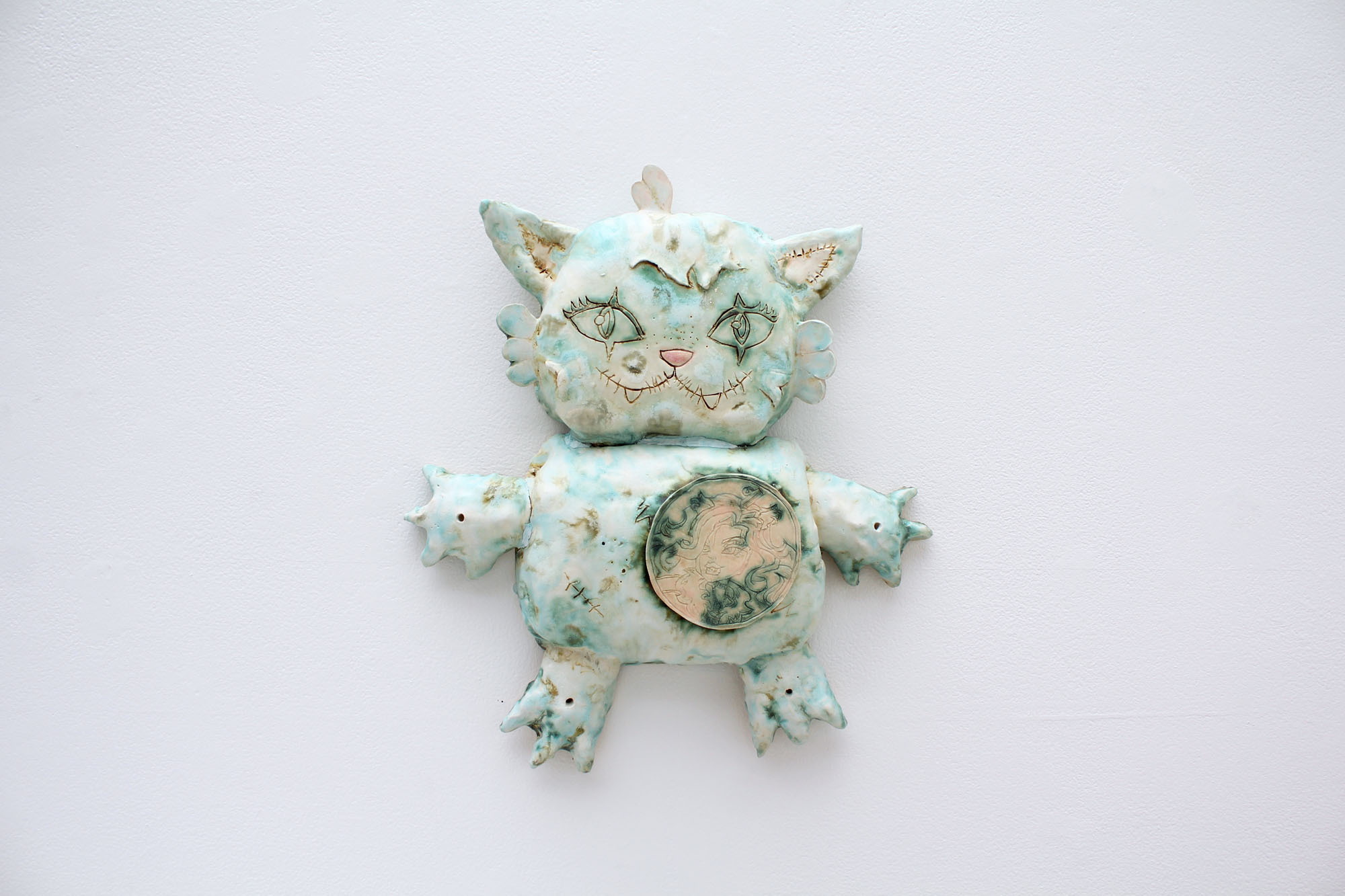
GJ: So you said you’re making a new three part altarpiece… how do you think that would differ from the one at Hotel Art Pavilion (HauntedAltarpiece)? That work feels emblematic of a transitional moment for you, where the sphinx-type characters are being flattened and maybe left behind or memorialized. Then there are also the masks that have the same ceramic texture, but are flat too and almost functioning in a more painterly way. There’s acrylic, and the ribbons that feel more in line with what you’re currently making. How would you compare this work with the new altarpiece in process?
EP: This new altarpiece is all lasercut acrylic and it’s based on Renaissance compositions. HauntedAltarpiece was ceramic, with the turquoise, aged copper color palette from my Bomarzo777BCE series and a Catholic altarpiece structure. The new acrylic pieces are sleek and sterile, but with a baby color palette and narrative symbolism that becomes maximalist and excessive. It looks like an insane little girl would have it in her room.
GJ: Love that. That’s my ideal art object. When I think of your work, or Flannery Silva’s— and there are other artists too: Jasper Spicero, Bunny Rogers, and Diamond Stingily at times… they’re making work that I feel like they imagined for themselves as children, or imagine a child having but also destroying… I find that intention or outcome really precious. A lot of people compare artmaking to play, or occupying a child-like essence to make work, and to embody that feels really right.
EP: We are all about the same age, and grew up in a time of lost innocence, with the rise of the Internet and everything. I just had such a bizarre feeling about life when I was a kid. A lot of the work is engaging with that sickness.
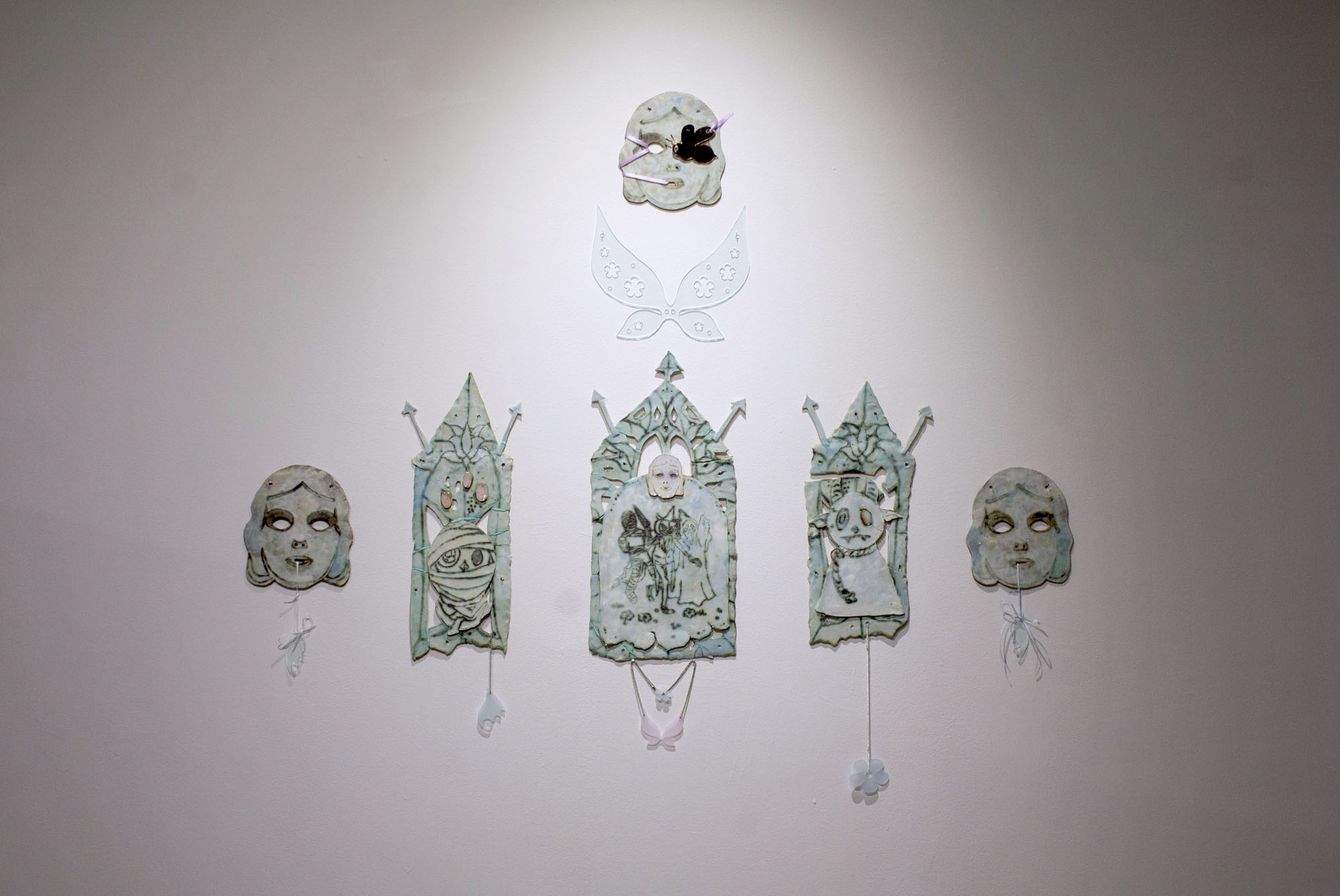
GJ: Can you say more about that feeling you had when you were young?
EP: There was a strong culture of fear and paranoia, you’d hear about people poisoning kids’ Halloween candy, or these white vans that would follow you home, or stalkers… The sensationalized murders— the OJ trials and the JonBénet Ramsey murder, Columbine, 9/11. School felt like a prison. Time would move so incredibly slowly. In the Midwest where I grew up, everything was so standardized and rigid, there’s just an ugliness about it. I fantasized about a different kind of life in a different kind of world.
GJ: As a form of protection.
EP: Or as a form of escape. I feel like there was this strong tension in our childhoods between seduction and fear. Mass media was and still is very surreal. We didn’t watch TV at my house so I would go to friends’ houses just to watch TV. I would instantly become glued to the screen, it was like a portal. I was obsessed with MTV, where you would see both the positive and negative sides of entertainment media, the dynamic and the exploitative.
GJ: Totally. We grew up in this moment where the 24 hour news cycle was born too. I was in third grade when 9/11 happened. The proverbial boogeymen you described earlier would emerge on TV and be broadcast in a sensationalized way all day. I remember being so afraid of everything, but I can’t even imagine what I would have been like if my parents had been more liberal in letting me use their computer. If a child is contending with the original fears of being orphaned, lost, taken or violated, or even just terrified by ~ the dark ~ or something out there, then those anxieties become invested in stories about kidnappings, or the feeling that the school itself is not safe. I don’t understand how those fears would be reinvested, let alone coped with, if you had access to a networked tablet or something like that, or were reckoning with this thing known as climate change. What is going to happen to the children of today? How are they not psychotic?
EP: Maybe they are; reality is becoming fiction and vise versa. But there needs to be a complete breakdown in the system, both structurally on the outside and psychologically on the inside. We need a new renaissance.
Interview conducted by Gabrielle Jensen with Emma Pryde for O Fluxo, November, 2019.
O FLUXO is an online platform for contemporary art.
EST. Lisbon 2010
Follow us:
@instagram
@facebook
O FLUXO
© 2023
